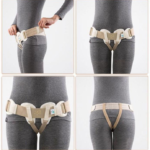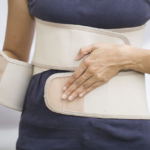The use of a bandage for abdominal hernia
The exit of the abdominal organs through a defect in the muscles of the anterior wall of the abdomen is defined as a hernia. This disease is diagnosed in people of any gender and age, but the tactics of treatment may differ slightly. In a child, a hernia of the abdominal cavity can be reduced independently, but after 6 years, surgical removal is indicated. The operation is always assigned to adult women and men.
Conservative treatment is considered as a temporary measure in the period of preparation for surgery or when there are contraindications to it. Non-surgical therapy includes medication, rest, diet and wearing a special corset.
A bandage for a hernia of the abdomen is an important preventive measure, because it fixes the organs in their place, preventing them from protruding even more. Before and after the operation, the attending physician individually determines how long the support and postoperative bandage should be worn, which will depend on the clinical manifestations and the results of the ultrasound examination.
A bandage for a hernia of the abdomen will be only a temporary measure, because before and after the removal of the hernia, the muscles need to be strengthened, and the corset does not contribute to this at all, taking on most of the load.
Bandage application
The support belt is prescribed for children and adults with a diagnosis of abdominal hernia. It is considered as a prophylactic, and does not guarantee the reduction of the protrusion. Its use in pathology in infants and children can lead to recovery without the need for surgery, but for this, in addition to wearing it, other measures must be followed.
A hernia bandage will be necessary when there is a risk of complications, and the most common is strangulation. This condition is manifested by severe pain, dyspeptic symptoms, fever, strong bulging and fixation of the formation in the abdomen. When the infringement has already occurred, putting on a bandage is strictly contraindicated, because this will lead to even greater squeezing of the organs.
If it is regularly used for prevention during physical work, this will reduce the risk of sudden infringement.
The corset is prescribed only at the initial stages of hernia formation. It will be a means of fixing the protrusion until the surgical intervention is performed. When the hernia increases, the corset can already harm, therefore, with large protrusions, it is prescribed individually.
The use of a support bandage is considered in such cases:
- preparation for the operation;
- period of gestation;
- heavy physical work;
- postoperative period;
- premature newborns with a predisposition to hernia.
Contraindications
The large size of the hernial sac, infringement and other complications are absolute contraindications to the use of a bandage. There are also relative limitations to its use that require individual consideration.
Fixing and postoperative bandage is not recommended in such cases:
- the first days after the operation;
- frequent constipation;
- pathology of the gastrointestinal tract;
- severe degree of obesity;
- undifferentiated disease of the abdominal cavity;
- heart failure;
- acute dermatological diseases;
- open wounds on the skin: cuts, inflammation, abrasions.
With a hernia of the abdominal cavity, patients often have digestive disorders.
The patient is concerned about pain in the stomach, discomfort after eating, frequent heartburn. On the part of the intestines, constipation and bloating are noted. These conditions not only add unpleasant symptoms, but also contribute to the progress of the disease. Wearing a bandage with such a complex of disorders is considered by the attending physician after the examination.
Types of bandages
By appointment, the following types of bandages are distinguished:
Umbilical.
Shown in the localization of the protrusion in the umbilical ring. It is often prescribed to young children after birth with an acquired disease against the background of muscle weakness and frequent crying or screaming, in which case there is still a chance of self-reduction of the defect and closure of the umbilical ring. If the child is diagnosed with a congenital pathology, the operation will be performed without fail, and according to indications, also during pregnancy.
The umbilical hernia bandage is an elastic belt with fasteners and a palette that fixes the defect.
Such a belt, like others, is made of hypoallergenic materials. More expensive and high-quality models absorb moisture and allow air to pass through, which prevents irritation of the child's skin. How long you need to wear such a belt determines the period of the disease before surgery and the technique of hernia repair. If laparoscopic hernioplasty has been performed, you will need to wear a corset for no more than 2-3 weeks for several hours a day. After carrying out a tension hernioplasty, the postoperative bandage will need to be worn longer, because the healing of the scar and tissues is a long process.
Inguinal.
The inguinal hernia bandage is a unisex belt for men and women with unilateral and bilateral protrusion. It is a product in the form of swimming trunks with pockets for pilots and straps. It is used both for the prevention of pathology during physical work and sports, and for the appearance of an inguinal hernia.
Abdominal.
Such a belt is used in the case of a hernia of the white line and as a postoperative corset after removal of the hernia. It supports the abdominal organs, preventing them from protruding during an increase in intra-abdominal pressure and with a high load on the abdominal muscles.
For pregnant.
A corset for women during the period of gestation is indicated to reduce the load on the muscles of the anterior abdominal wall. It is put on for several hours a day, and pregnant women at the same time notice an improvement in well-being. In women during this period, an umbilical hernia often occurs, and the bandage in this case will unload the muscles, reducing soreness, and at the same time supporting the organs in their place.
Postoperative.
The bandage after the operation looks like a wide elastic belt. It wraps around the abdomen and chest, ensuring normal healing of the surgical scar without the risk of disruption and divergence of the suture. Such a corset is essential for the prevention of recurrence and postoperative hernia. The latter is the result of non-compliance with the regimen after surgery and errors during hernia repair.
Children's bandage.
Corsets for hernia in children are made of soft hypoallergenic material that allows air to pass through. They are equipped with semi-rigid inserts located slightly above the navel. The purpose of such a belt will be the prevention of hernia in congenital muscle weakness and an attempt to treat hernia in infants when there is a possibility of the defect being reduced without surgical intervention. More often in infants and newborns, an umbilical hernia occurs. The belt with such localization of education is selected by the doctor, taking into account the age of the child. The corset does not cause discomfort to the child, if only it is properly put on and not left for a long time.
The bandage must be removed during sleep. Massage and gymnastic exercises are also performed without a belt.
Bandage selection
You can buy a bandage in specialized medical stores. It will not be easy to make a choice on your own, given the variety of models from different manufacturers. The attending physician will help you choose the belt, who will then show you how to put it on correctly, how much to tighten and how much to wear the bandage.
What is important when choosing a bandage:
-
the belt should fit perfectly in size, not squeeze the stomach;
-
it is better to choose fastening with Velcro, because such a belt is more convenient to put on and take off;
-
the corset should be comfortable, the correct belt does not restrict movement;
-
you need to buy a bandage only after trying it on.
Make a purchase in specialized stores where there is a choice, and all products are released in accordance with the requirements.
A bandage for a hernia of the abdominal cavity can not be worn by all patients. Some patients experience increased soreness after several days of wearing. In this case, you can try another belt or have to abandon it, which will add more restrictions to everyday life.










